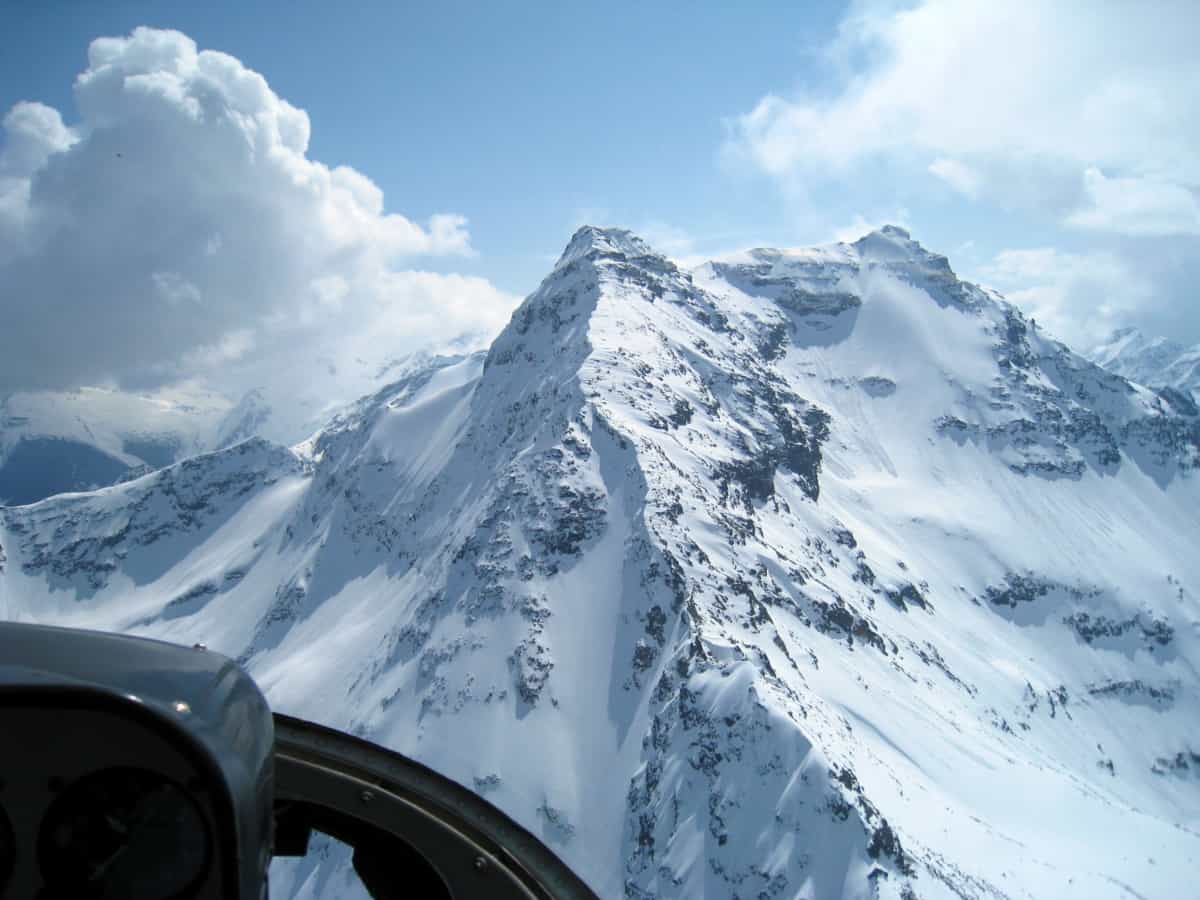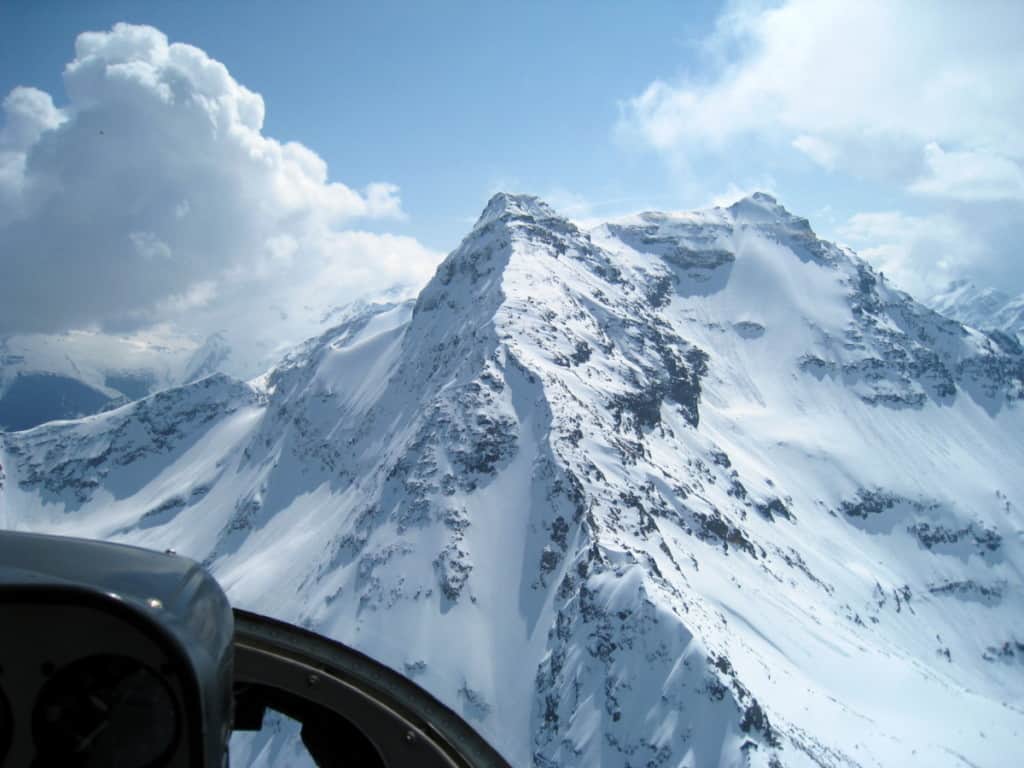
Flying high in a helicopter takes some remarkable feats of design and engineering. Although helicopters cannot fly as high as their fixed-winged counterparts they can do remarkable things like rescue people off some of the world’s highest mountains!
Most helicopter manufacturers limit their helicopters to around 20,000-25,000 feet for normal flight operations. The official altitude record for a helicopter flight is 12,954 m (42,500 ft) set by Fred North in 2002 and the highest landing was on Mount Everest at 8,848 m (29,030 ft) in 2005.
So why can’t a helicopter fly as high as a plane? As with everything in aviation, being able to fly high requires performance that is always a trade-off between engineering, aerodynamics, and commercial pressures.
Read on to find out some interesting stuff about what limits how high a helicopter can fly.
What are the Helicopter Altitude Records?
Highest Altitude Flight:
Fred North – March 23, 2002, in a Eurocopter AS350 B2 flew to 12,954 m (42,500FT) – Source: Fred-North.com
Highest Landing:
Didier Delsalle – May 14, 2005, in a Eurocopter AS350 B3 landed on top of Mount Everest at 8,848 m (29,030 ft) – Source: Eurocopter
Highest Worldwide Rescue:
Maurizio Folini – May 19, 2013, in a Eurocopter AS350 B3 rescued double-amputee Sudarshan Gautam on Mount Everest at 7,800 m (25,590 ft) – Source: Men’s Journal
Highest US Rescue:
Adam Hermanski – May 12, 2011, in a Eurocopter AS350 B3 rescued Jerry O’Sullivan on Alaska’s Denali (Mount McKinley) at 6,045 m (19,833 ft) – Source: Wired Magazine
As you can see the Eurocopter AS350 series helicopter is a formidable altitude smashing machine!
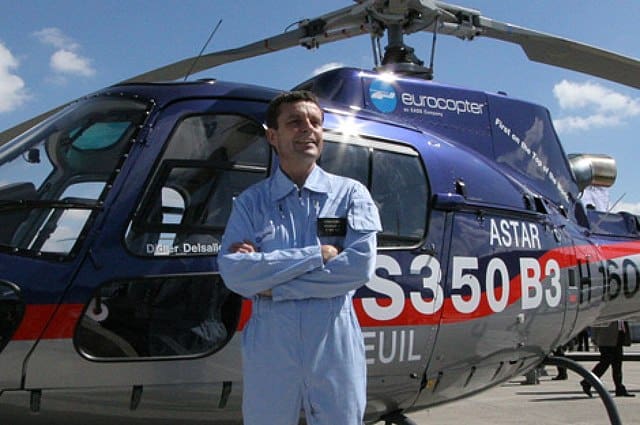
Being able to break records and fly high in a helicopter requires the following barriers to be overcome:
Environmental Factors
Aerodynamic Factors
I’ll try and keep these as simple to follow so I will leave out all the complex stuff that I can!
Environmental Factors
These factors are what the aircraft uses to work with or off. Depending on the environmental conditions at the time of the flight they can seriously impede how high a helicopter can fly.
The four arch enemies to helicopter performance are:
- Hot Air
- High Altitude
- Humid Air
- Heavy Aircraft – Covered Later
Lets look at these in layman’s terms:
Temperature
As the temperature of an air molecule increases, it vibrates more. Think of an elevator full of people. If everyone is standing still you can fit more people. If everyone is dancing, you can’t fit as many people.
Swap these people for molecules of air in a given space, let’s say a 1-foot cube. The hotter the temperature, the more the air molecules vibrate, thus the fewer molecules will be able to fit in that 1-foot cube.
A helicopter engine needs air (oxygen) molecules for combustion.
Fewer Air Molecules = Less Combustion = Less Power
A helicopter’s rotor blades need air molecules to work off to create lift.
Fewer Air Molecules = Less To Work Off = Less Lift
Therefore, the cooler the air, the higher a helicopter can go. A helicopter flying in Alaska at 10,000 ft will have more air molecules to work on/with than a helicopter in the tropics at 10,000 ft.
Altitude
As you go higher in the atmosphere the air pressure reduces. Less air pressure means fewer air molecules in any given space. Take the 1-foot cube again. The cube at sea level will have every air molecule above it being pulled to the surface by gravity, so the cube will be tightly packed with molecules.
That same cube at 10,000 ft will have less air molecules above it being pulled down, so fewer air molecules will be packed into the cube.
A helicopter engine needs air (oxygen) molecules for combustion.
Fewer Air Molecules = Less Combustion = Less Power.
A helicopter’s rotor blades need air molecules to work off to create lift.
Fewer Air Molecules = Less To Work Off = Less Lift.
Therefore, the higher a helicopter flies, the less air pressure, thus the fewer air molecules the engine and rotor blades have to work with/on.
Humidity
The amount of moisture contained in the air is its humidity. At 100% humidity that 1-foot cube is completely saturated with moisture and the air parcel cannot hold any more. Moisture takes up space that air molecules could occupy and it doesn’t burn in a helicopter engine!
The More Moisture In a Given Parcel of Air = The Less Combustion the Engine Will Have = The Less Power It will Produce
Therefore, the less humid the air, the higher the helicopter can go because the engine performance is better. A helicopter flying in dry Alaska at 10,000 ft will have less moisture impeding it than a helicopter in the humid tropics at 10,000 ft.

Join My Newsletter & Get Great Tips, Information and Experiences To Help You Become a Superb Pilot!
Mechanical Factors
Weight
The more the helicopter weighs, the more lift it has to generate to overcome that weight and get it airborne.
When you factor in Heat, Air Pressure, and Humidity, the worse those are the harder the engine and rotor blades have to work to lift that weight.
For Example:
An AS350 B2 is at a maximum gross weight of 4961 lbs and it can only climb up to 15,000 ft.
Land and remove 2 passengers and it now weighs 4561lbs and now it can climb to 17,000 ft.
The more weight you remove, the less the engine and rotor have to work, and the higher you can go before one of them reaches its limit.
Most high-altitude rescue helicopters are stripped of every non-essential item – Passenger Seats, Avionics, Accessories, you name it – If it’s not needed: It’s Removed!
Engine Performance
The engine needs fuel and oxygen to work. Generally, fuel is never a problem – Unless it runs out so that leaves oxygen. As mentioned above, the fewer oxygen molecules to work with the less power it produces.
A helicopter engine, like any engine, can only produce a maximum amount of power, once that limit is reached it cannot produce anymore.
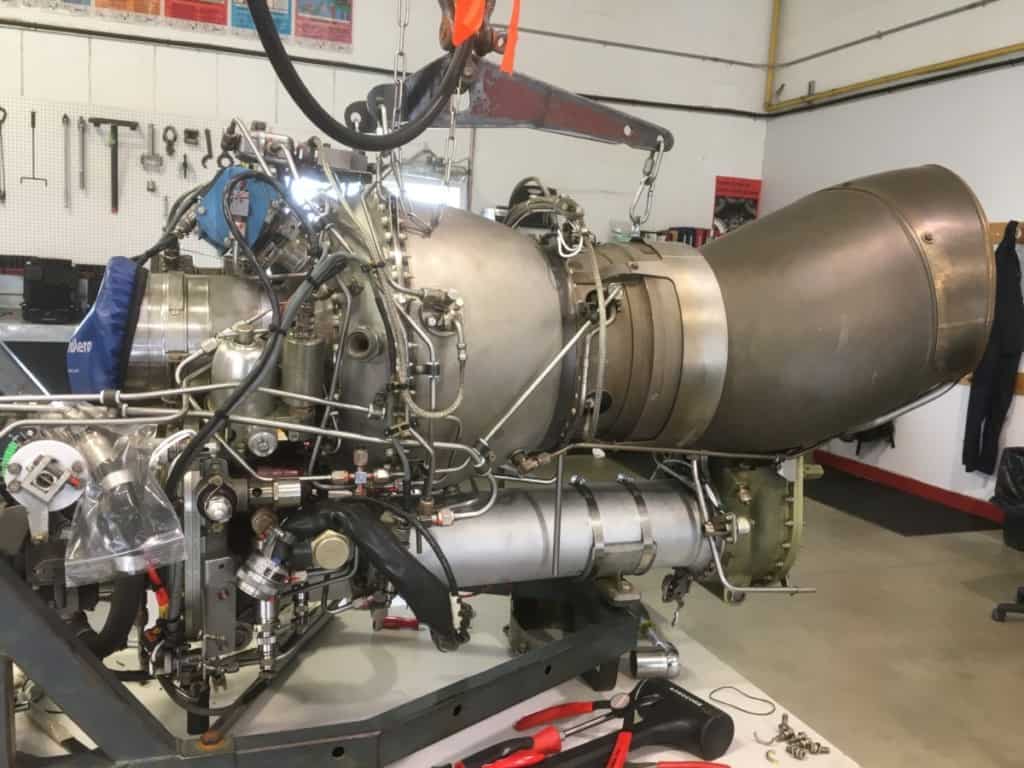
Helicopter engines are designed to produce power to turn the transmissions which turn the main/tail rotors at a fixed RPM. As blade pitch increases, the drag each blade creates increases, and more engine power is required to push that blade through the air to maintain the required RPM.
Think of it like pushing a kids’ stroller at 5mph along a path – easy right! Now try keeping 5mph through a muddy field!
More drag on the wheels = You have to work harder!
The less the engine has to work, the higher it can go before it gets to its maximum power limit.
Cold, dry air will allow a helicopter to go higher that hot, humid air.
Controllability
Being able to control a helicopter at all points of the flight is pretty important! To control a helicopter the pilot needs to be able to control the Main Rotor, Tail Rotor, and Engine/s to keep the aircraft doing what it is supposed to: Fly Upright – Unless you are Chuck Aaron flying in the Redbull Chopper!
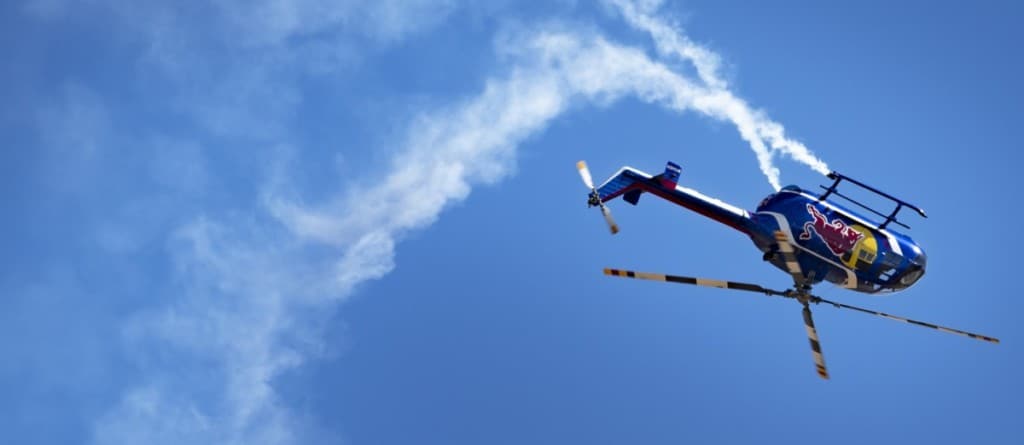
For all the blades to work they need sufficient air molecules to work on and the engine needs enough air molecules to create enough power. As air molecules in a given area become reduced, the efficiency of which all the blades and engine/s work will reduce.
If there are endless amounts of power ( there isn’t 😉 ), the pilot will find the air becomes too thin for the rotor/tail blades to work off and either the aircraft will stop climbing or the helicopter can begin to rotate because the effectiveness of the tail rotor is not sufficient to counteract the torque being produced from the main rotor. (For another article!)
Either way, the engine will run out of power or the blades will run out of lift. This will be the limiting factor to how high the helicopter can fly for the given environmental conditions.
Learn More…
Try These Articles:
* Are Helicopters Faster Than Cars? Well, It Depends…
* How Fast Can a Helicopter Fly? Top 10 Civilian & Military Comparisons
Regulations
For everyday helicopter operations, each helicopter comes with a Rotorcraft Flight Manual or RFM for short. This manual tells the pilot all the things they should and should not do with the helicopter.
The manual also comes with a plethora of performance charts that the pilot needs to ensure the helicopter will perform as expected in any given environmental condition.
The data in these charts are flown and extrapolated during the certification process of each helicopter type by the company’s test pilots. For most helicopters, if the chart says it can do it, then it can do it.
Some manufacturer’s data is better than others 😉
RFM Limitations & Performance
Maximum Altitude Limitation
To keep pilots safe one of the limitations in each manual is the Maximum Flight Altitude. This is for use in any operation whether it be in forward flight or hovering. This figure has been calculated to ensure full controllability of the aircraft to keep the occupants safe.
Helicopter Altitude Limit Examples
| Helicopter Type | Altitude: Meters | Altitude: Feet |
|---|---|---|
| Schweizer 300CB | 3,050 m | 10,000 ft |
| Robinson R22 | 4,250 m | 14,000ft DA |
| Bell 206 Jet Ranger | 4,100 m | 13,500 ft DA |
| Eurocopter AS 350 Astar | 6,100 m | 20,000 ft |
| Eurocopter SA 315B Lama | 7,000 m | 23,000 ft |
| Agusta A139 | 6,100 m | 20,000 ft DA |
| Mil Mi-26 | 4,600 m | 15,100 ft |
| Boeing Chinook CH-47F | 6,100 m | 20,000 ft |
For helicopter operators to operate at altitudes higher than this limitation they can apply for ‘Limitation Waivers’ from their local aviation governing authority ie: FAA.
These waivers will grant the operator permission to operate within a specific set of limitations, policies, and procedures applicable to high-altitudes to ensure rescue work can take place safely and without breaking any regulations or voiding their insurance.
Hover In Ground Effect (HIGE) Performance
Hovering requires the most power from an aircraft engine. Hovering In Ground Effect is when the helicopter hovers no more than roughly 1.0-1.5x its rotor diameter above the surface.
Eg: Robinson R22 Rotor Diameter = 25 ft
HIGE = Main Rotor remains below 37 ft above the ground/surface
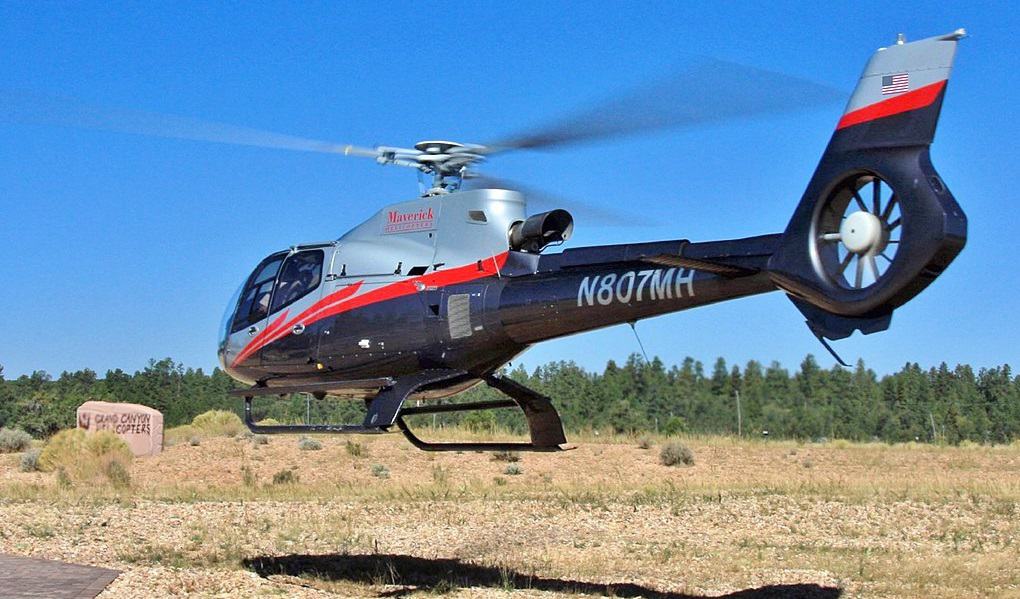
This ‘Ground Effect’ helps to improve aerodynamic performance and requires less power to hover the helicopter than if the helicopter was trying to hover 200ft above the ground.
HIGE performance charts show the pilot the maximum altitude they can safely hover for a given temperature, air pressure, weight, and wind.
For Example:
Eurocopter AS350 B2:
- Aircraft Total Weight (Fuel, Pilot, Passengers, Gear) = 4800 lbs
- Proposed Landing Spot Elevation = 7000 ft
- Wind at Landing Spot = Calm
- Temperature at Landing Spot = +10°C
WITH NO External Load: Aircraft Max Gross Weight = 4961 lbs
Checking the HIGE performance chart for that data shows the aircraft can safely operate at that altitude at maximum gross weight. Because the current helicopter is 161 lbs under its maximum gross weight there will be surplus performance available.
Next, the passengers need lots of construction equipment long-lining to the same spot. Now the pilot has to look at HOGE performance.
Learn More…
Try These Articles:
* Do Helicopter Pilots Wear Parachutes?
* Can a Helicopter Carry a Car? In Hollywood Yes, But in Real Life?
Hovering Out Of Ground Effect (HOGE) Performance
Hovering Out Of Ground Effect is when the helicopter’s main rotor is hovering higher than 1.0-1.5 its rotor diameter. This usually occurs when helicopters are winching, putting out fires with a water bucket, or slinging loads using a Long-Line which are too big/heavy to fit in the aircraft.
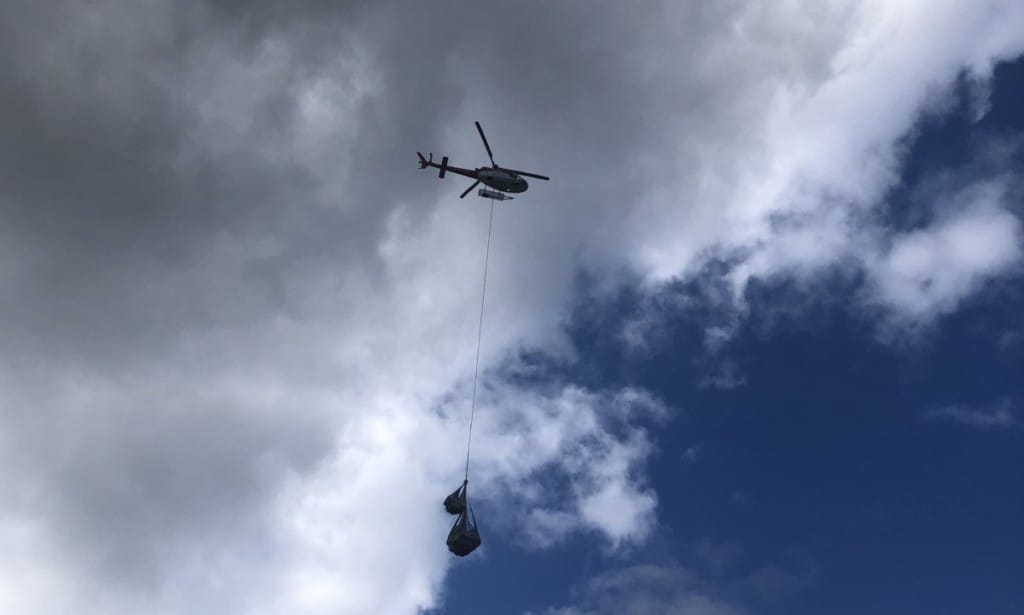
Hovering Out Of Ground Effect requires the most performance from the engine and the rotor system. The rotors do not benefit from the aerodynamic assistance they get when hovering close to the ground and the altitude the helicopter can hover at is far lower.
Using some of the same data as before:
For Example:
Eurocopter AS350 B2:
- Aircraft Total Weight (Fuel, Pilot, No Passengers, External Load) = 4900 lbs
- Proposed Landing Spot Elevation = 7000 ft
- Wind at Landing Spot = Calm
- Temperature at Landing Spot = +10°C
WITH External Loads Aircraft Max Gross Weight Upgraded = 5512 lbs
Checking the HOGE performance chart for that data shows the aircraft can safely operate at that altitude at no more than 4900 lbs.
Because the calculated total helicopter weight is 4900 lbs that does not leave enough safety margin.
To safely complete this flight the pilot needs to reduce weight: Either the aircraft needs to take less fuel or take the load in two runs.
To Finish
As you can see there are many factors that will influence how high a helicopter can go. The same helicopter with the same load, fuel, load etc will be able to go higher in the morning when the air is cool vs the same exact flight in the afternoon when the air is hot.
Flying over Mount Everest is one thing, but being able to land and pick up someone is just not available at this point in time. As engines become more powerful and helicopter design & performance improve there may be a time when anyone can be rescued from the world’s tallest peaks – Weather permitting.
When operating in Hot, High, or Humid conditions every pilot needs to reference their helicopter’s RFM to ensure their helicopter will do what they expect it to do and not run out of performance just at the wrong time!

